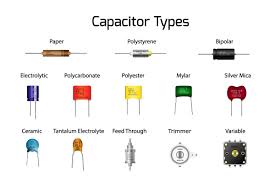In the intricate world of electronics, where tiny components work in harmony to power our devices, the capacitor often plays a crucial, yet understated role. You might not see it, but it's there, storing and releasing electrical energy like a miniature battery, contributing to the smooth operation of everything from your smartphone to your car.What is a Capacitor?At its core, a capacitor is a passive electronic component that stores electrical energy in an electric field. It consists of...
In the intricate world of electronics, where tiny components work in harmony to power our devices, the capacitor often plays a crucial, yet understated role. You might not see it, but it's there, storing and releasing electrical energy like a miniature battery, contributing to the smooth operation of everything from your smartphone to your car.
What is a Capacitor?
At its core, a capacitor is a passive electronic component that stores electrical energy in an electric field. It consists of two conductive plates separated by a dielectric material (an insulator). When voltage is applied across the plates, an electric field forms between them, causing an accumulation of electrical charge. Think of it like a water tank: the plates are the walls, and the dielectric is the space between them. When you pump water (charge) into the tank, it fills up. When you open the valve, the water (charge) flows out.
How Does a Capacitor Work?
- Charging: When a voltage is applied, electrons accumulate on one plate, creating a negative charge. This repels electrons from the other plate, creating a positive charge. The dielectric prevents the charges from directly flowing between the plates.
- Storing: The electric field between the plates stores the electrical energy. The amount of charge stored is proportional to the voltage and the capacitance of the capacitor.
- Discharging: When the voltage source is removed, the stored charge can flow out of the capacitor, releasing the stored energy.
Key Characteristics of a Capacitor:
- Capacitance (C): Measured in Farads (F), capacitance is the ability of a capacitor to store charge. A larger capacitance means it can store more charge at a given voltage.
- Voltage Rating: The maximum voltage that can be safely applied across the capacitor. Exceeding this rating can damage the capacitor.
- Tolerance: The allowable variation in the actual capacitance value from the stated value.
- Temperature Coefficient: How the capacitance changes with temperature.
- ESR (Equivalent Series Resistance): A measure of the internal resistance of the capacitor.
Types of Capacitors:
Capacitors come in a wide variety of types, each suited for different applications:
- Ceramic Capacitors: Small, inexpensive, and widely used in general-purpose applications.
- Electrolytic Capacitors: Offer high capacitance values, but are polarized (they have positive and negative terminals). Used in power supplies and filtering circuits.
- Tantalum Capacitors: Similar to electrolytic capacitors, but with better temperature stability and smaller size.
- Film Capacitors: Offer good stability and low losses, used in audio and high-frequency circuits.
- Supercapacitors (Ultracapacitors): Very high capacitance values, used for energy storage in applications requiring rapid charging and discharging.
Applications of Capacitors:
Capacitors are essential components in countless electronic devices:
- Filtering: Smoothing out voltage fluctuations in power supplies.
- Coupling and Decoupling: Blocking DC signals while allowing AC signals to pass.
- Timing Circuits: Used in oscillators and timers.
- Energy Storage: In flashlights, cameras, and hybrid/electric vehicles.
- Signal Processing: In audio amplifiers and radio receivers.
- Motor Starting: Helping to start electric motors.
Why Capacitors Matter:
Capacitors are indispensable components that enable the functionality of modern electronics. From smoothing out power supply ripples to storing energy for rapid bursts, they play a vital role in ensuring the stability, efficiency, and performance of our devices.
While they might not be as flashy as microprocessors or displays, capacitors are the unsung heroes of the electronic world, quietly working behind the scenes to keep our digital lives running smoothly.
